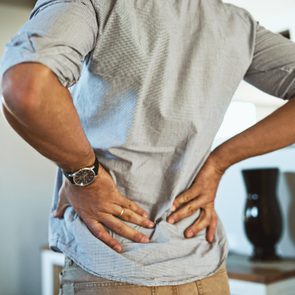8 Best Leg Stretches to Do Before and After Working Out
Updated: Jul. 28, 2023
Leg stretches can help you maintain lower body mobility and prevent injury and pain. Here's how to do them before and after your workout routine.
The importance of stretching your legs
How flexible is your bottom half?
Maintaining full mobility in your lower body is incredibly important for long-term health and well-being. Not only is it obviously key for basic life skills like walking, climbing stairs, and getting up and down from chairs, but it can help prevent injury and make you feel better, too.
“The joints in the lower body, especially the hips and knees, require a full range of motion to maintain the health of the cartilage and other structures of the joint,” says Philip Scuderi, a chiropractor and the founder of Basis Medical Palm Beach County, Florida.
“A full range of motion is essential to ensuring the joint is supplied with an adequate amount of blood and nutrients.”
Unfortunately, daily habits, previous injury, and aging can all work against you when it comes to maintaining your range of motion.
That doesn’t mean you can’t maintain the range of motion of the joints of your legs, it just means that without working on it, it becomes harder. That’s why including leg stretches as a part of your weekly routine is so important.
The goal with these stretches isn’t necessarily to get “extra flexible,” rather it’s to maintain flexibility for comfortable movement which can pay off when it comes to injury and pain prevention.
Leg stretches and mobility, flexibility, and range of motion
“Inflexibility causes muscles to tire at accelerated rates. Muscle fatigue can lead to the muscle’s inability to protect the joint from injuries like tears, pulls, and strains,” explains Dr. Scuderi.
He gives the example of how the hamstring plays a role in stabilizing the knee—if the hamstring is inflexible, tires more quickly, and can’t appropriately stabilize the knee, the joint becomes more susceptible to injuries like anterior cruciate ligament (ACL) tears.
Lara Heimann, a physical therapist and the founder of LYT Yoga also emphasizes how poor muscle balance and range of motion at one joint can lead to injuries in other areas of the body.
“If the ankle range of motion is limited, the knee will ‘make up for’ the limitation and may move excessively, creating a sheer on the patella (the knee cap),” she explains.
This increased pressure placed on the knee can lead to irritation, muscle pain and knee pain, and ultimately, limited range of motion at the knee. And because no single body part works without relying on other body parts (your body is a system, after all), this type of “creeping injury” can continue and result in more pain and other injuries.
“The limited range of motion in the hip and ankle not only contribute to suboptimal mechanics of the knee, but can also lead to imbalance in the surrounding tissues and in the motor-firing of the surrounding muscles,” says Heimann.
In other words, if you don’t pay attention to maintaining the flexibility in your legs through stretching and other exercises, you’re opening yourself up to a world of potential pain.
(Here’s how to stretch your ankles so you can move easier.)
How to add leg stretches into your pre-workout routine
Dr. Scuderi emphasizes the importance of stretching your lower body before any physical activity. But that doesn’t mean you should spend a lot of time doing standing quad stretches or calf stretches while your body’s still cold.
Rather, you should focus on dynamic stretches (those that help get the blood flowing and require continuous movement) before your workout as part of your warm-up.
“Dynamic stretches are controlled movements that prepare your muscles, ligaments, and other soft tissues for performance and safety,” he says.
After a few minutes of walking or jogging, dynamic stretches might include movements like hip circles, high knees, side lunges, and squats. Heimann, in particular, likes incorporating lunges into her clients’ warm-ups.
“Lateral lunges are important because they pull on the adductors (the inner thighs) which are often shortened, potentially leading to a pull on both the knees and the low back,” she says, while low lunges can help stretch the hip flexors and quads.
Pre-workout leg stretches
Walking knee-to-chest
The knee-to-chest stretch is a good way to fire up all the major muscles and joints of your lower body, including your calves, quads, hamstrings, hip flexors, and glutes.
You can do this stretch while walking forward, or you can do it while standing in place.

How to do it
Lift your right foot from the ground, flexing your ankle to take a step forward. Bring your knee high, flexing your knee and hip past 90-degree angles. As you lift your knee, “catch” the front of your right shin with both hands and use your hands to help pull your knee toward your torso until you feel an easy stretch in your hamstrings and glutes.
Place your right foot on the ground (either stepping forward, or returning to the original position) and repeat on the left side. Continue alternating legs for a full minute.
High kicks
High kicks are another good leg warmup exercise that will help stretch the hamstrings, glutes, and calves, while requiring engagement of the hip flexors and the quads.
You can perform this exercise standing in place or walking forward, depending on the space you have.
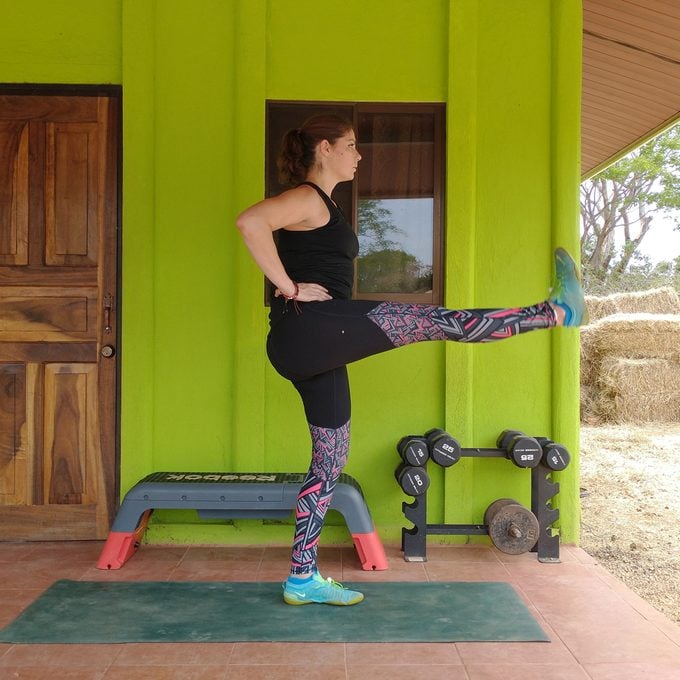
How to do it
Standing tall with your hands on your hips, your feet roughly hip-distance apart, kick your right foot as high as you comfortably can in front of you, your knee straight, ankle flexed, so you feel a stretch on the back of your thigh. Lower your right foot to the floor, either taking a step forward, or remaining in place.
Even though this is a “kick” motion, it should remain controlled and without using momentum of other muscle groups.
In particular, your upper body and torso should remain steady and shouldn’t be tipping forward or backward as you kick. Repeat to the opposite side and continue alternating sides for one minute.
Dynamic lateral lunges
The lateral lunge will fire up your quads, hamstrings, and glutes, while also stretching out your inner thighs.
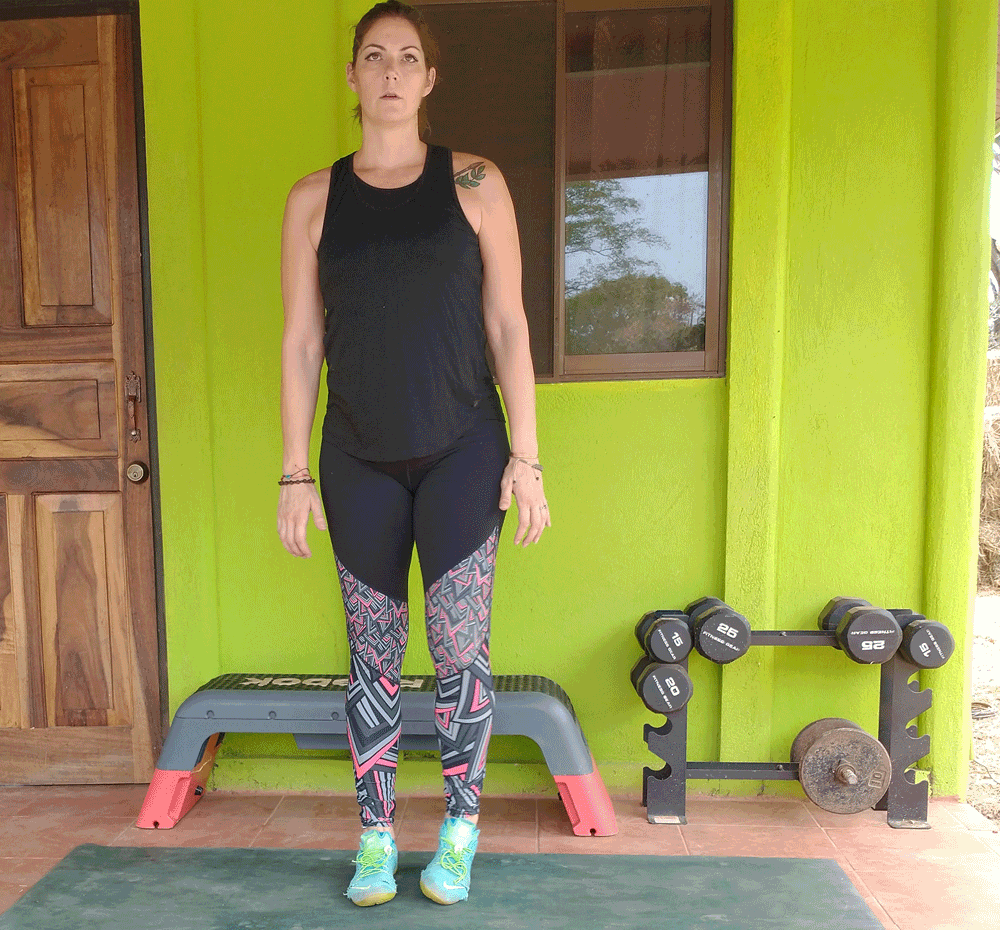
How to do it
Stand straight and tall, your feet roughly hip-distance apart. You can place your hands on your hips or have your elbows bent, your arms in front of you for balance. Take a step to your right, your right foot angling slightly outward.
Keeping your left leg straight, press your hips back and bend your right knee, making sure it stays aligned with your toes. When you feel a stretch through your inner left thigh, press through your right heel and step back to the starting position. Repeat to the left side and continue alternating sides for a minute.
Plank to down dog and pedal out
The plank to down dog is an excellent way to fire up your core, shoulders, hip flexors, and quads, while stretching out your calves, hamstrings, glutes, and upper back.
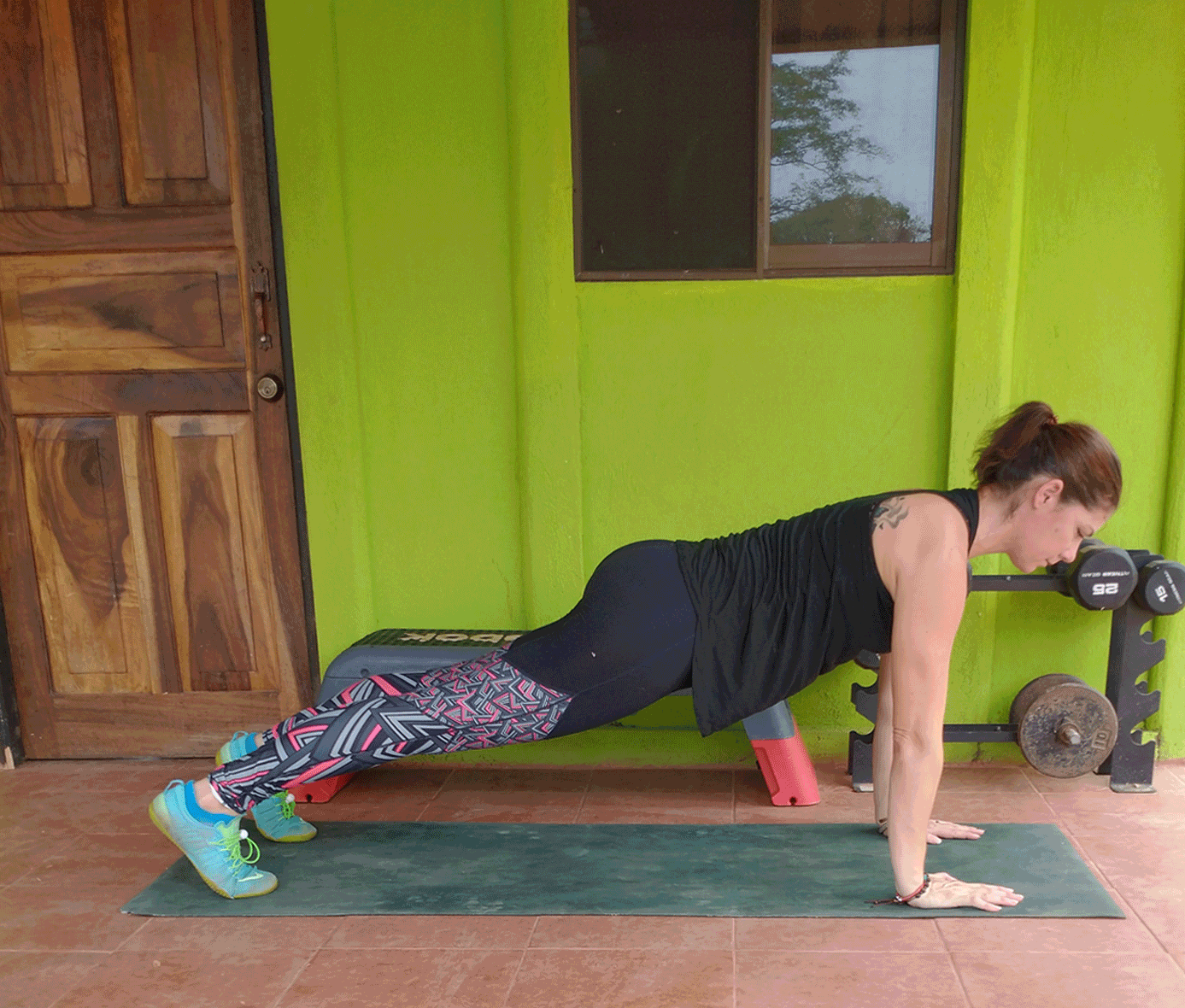
How to do it
Start in a high plank position with your palms under your shoulders and your body forming a straight line from heels to head. You should be supported on the balls of your feet and your palms.
With your core engaged, press your hips straight up in the air, pushing back through your shoulders to create an upside down “V” with your body.
You should feel a nice stretch through your calves, hamstrings, and glutes as you press your hips high. Your heels can remain lifted off the ground.
Hold for a breath, then “pedal out” your heels, pressing one heel toward the ground as you bend the opposite knee, then switching sides.
Perform two to three pedals per leg, return to downward dog and hold for a breath, then return to the high plank position.
Continue this cycle for a total of a minute.
How to add leg stretches into your post-workout routine
It’s not until after a workout that you should focus on more traditional, static lower-body stretches.
“Static stretches should be used as part of your cool-down routine post-workout,” says Scuderi. “Static stretches involve holding a single position for a slightly extended time period of about 45 seconds. Additionally, using static stretching regularly to maintain flexibility will help reduce the risk of injury.”
Whether you’re engaging in dynamic or static stretching, it’s important to pay attention to your body and not overdo it or push yourself to the point of pain.
“Pain is one indicator that you’re stretching incorrectly. You should only feel mild tension,” Scuderi emphasizes. He also adds that you should breathe deeply and focus on maintaining good posture. These two factors will help you relax into each movement without risking incorrect alignment or injury.
Post-workout leg stretches
Standing quad stretch
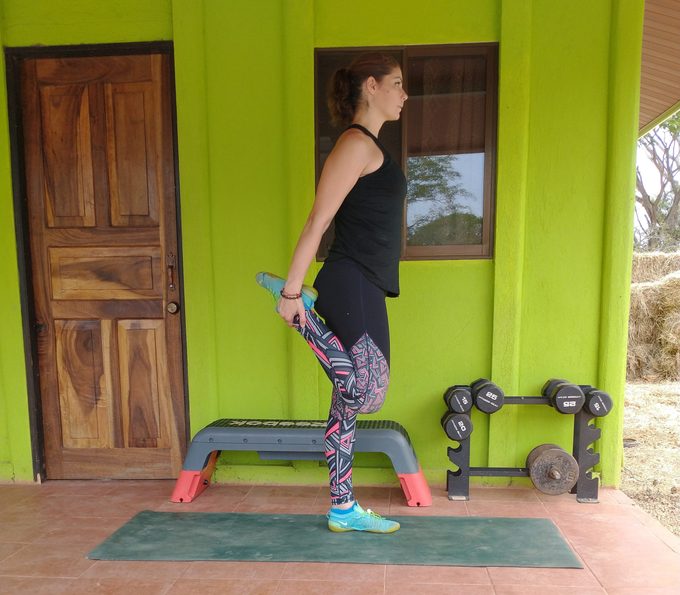
Stand tall, your feet roughly hip distance apart. If you need to, stand close to a wall or a sturdy chair to use it for support, placing your left hand lightly on the object.
Check your posture to make sure your core is engaged, your ears, shoulders, hips, knees, and ankles all aligned.
Shift your weight to your left leg and lift your right foot from the ground, bending your knee behind you and bringing your ankle toward your glutes.
As you lift your heel, “catch” your ankle with your right hand, and use your right hand to help pull your heel closer to your right glute. Stop when you feel a good stretch along the front of your right thigh. Hold for 30 to 60 seconds before switching sides. Repeat two to three times per side.
(Want more quad stretches? Try these moves.)
Kneeling hip flexor stretch
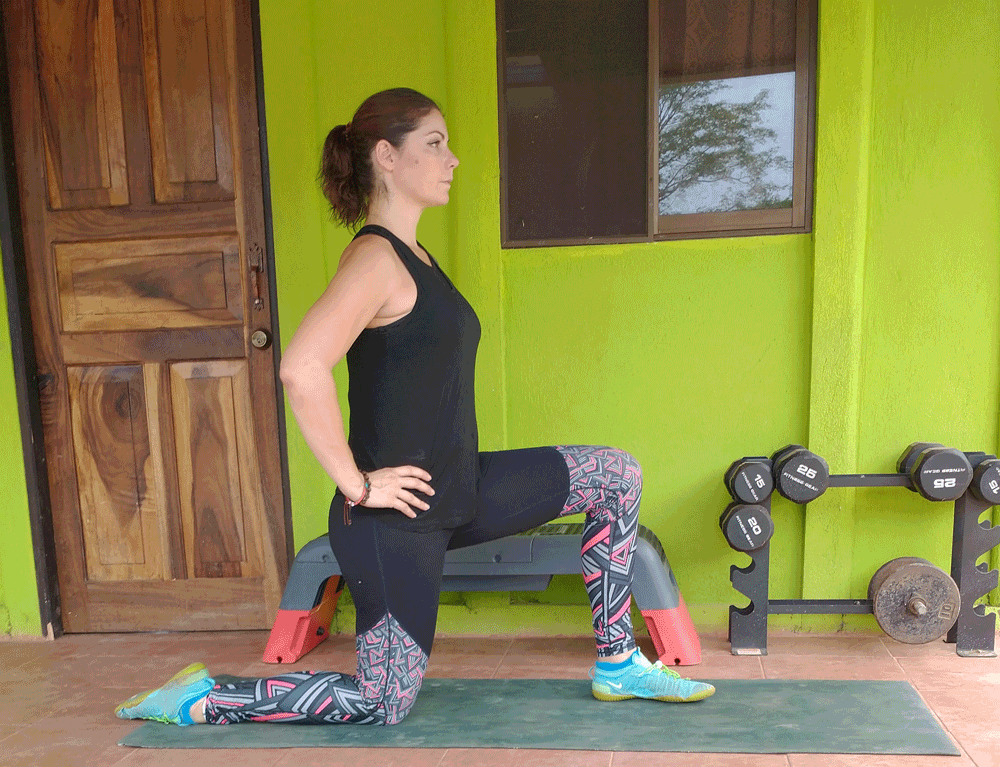
Kneel on the ground on a mat as though you were about to propose to someone—your right foot planted on the ground in front of you, your right knee and hip bent at 90-degree angles. Your left knee should be aligned directly under your hip.
Place both hands on your hips and engage your core, making sure you’re maintaining good posture, your shoulders back, your ear, shoulders, and hips aligned.
From this position, press your hips forward without leaning forward, extending your left hip flexor as you bend your right knee a little farther. When you feel a good stretch along the front of your left hip, hold the position.
Maintain the stretch for 30 to 60 seconds before switching sides. Repeat the stretch two to three times per side.
Seated hamstring stretch

Sit tall on a mat with your legs extended in front of you. Your upper body should have perfect posture, with your ears, shoulders, and hips aligned. Bend your left knee, drawing your left foot toward your glute.
Open your left knee outward, placing the bottom of your left foot on the inside of your right thigh at a position that feels comfortable. Allow your left leg to relax, the outside of your left leg resting on the floor (if it can) or at a comfortable angle.
Twist your torso slightly to the right so it’s squared with your right leg. Take a breath in and engage your core, then tip forward from the hips, maintaining good posture, leaning over your right thigh until you feel a stretch along the back of your right thigh.
You should not “collapse” over your thigh or try to touch your toes. The goal is to maintain perfect posture as you relax into the stretch.
When you feel the stretch, hold the position, breathing deeply and relaxing for 30 to 60 seconds. Switch sides and repeat. Perform the stretch two to three times per side.
Lying figure 4 stretch

To do the figure 4 stretch, lie on your back on a mat, your knees bent, your feet flat on the floor. Lift your right foot from the floor and place the outside of your right ankle across your left thigh, allowing your right knee to open outward. Your legs should be forming an upside down “4” shape.
From here, lift your left foot from the floor, bending your hips to bring your legs closer to your torso. When your left hip and knee form 90-degree angles, use both hands to grasp the back of your left thigh.
Use your hands to help draw your legs even closer to your torso. When you feel a stretch in your left glute, stop and hold the position for 30 to 60 seconds.
Repeat on the opposite side and perform a total of two to three sets per side.
Up next, try these stretches for lower back pain.





















